Tight Sandstone Reservoir Characteristics and Controlling Factors: Outcrops of the Shanxi Formation, Liujiang River Basin, North China
Abstract
1. Introduction
2. Geological Setting
3. Samples and Methods
4. Results
4.1. Petrological Properties
4.1.1. Clastic Composition and Features
4.1.2. Filling Features
4.2. Space Types
4.2.1. Primary Pores
4.2.2. Secondary Pores
- Dissolved pores between grains
- 2.
- Dissolved pores in grains
- 3.
- Macropores
- 4.
- Mold pores
- 5.
- Intercrystalline pores and micro-fractures
4.3. Physical Properties
4.4. Diagenesis
4.4.1. Mechanical Compaction
4.4.2. Cementation
- Siliceous cementation
- 2.
- Clay mineral cementation
- 3.
- Ferruginous cementation
- 4.
- Argillaceous cementation
4.4.3. Dissolution
5. Discussion
5.1. Sedimentation
5.1.1. Sedimentary Facies
5.1.2. Rock Composition and Texture
5.2. Diagenesis
5.2.1. Destructiveness of Diagenesis
- Compaction
- 2.
- Cementation
5.2.2. Constructiveness of Diagenesis
5.3. Tectonics
5.4. Research Significance
6. Conclusions
Author Contributions
Funding
Data Availability Statement
Acknowledgments
Conflicts of Interest
References
- Zou, C.N.; Tao, S.Z.; Hou, L.H. Unconventional Petroleum Geology; Geology Press: Beijing, China, 2011; pp. 18–23. [Google Scholar]
- Song, Y.; Jiang, L.; Ma, X.Z. Formation and distribution characteristics of unconventional oil and gas reservoirs. J. Palaeogeogr. 2013, 15, 605–614. [Google Scholar]
- Kang, Y.Z.; Zhou, L. The strategic thinking of unconventional petroleum and gas in China. Earth Sci. Front. 2016, 23, 1–7. [Google Scholar]
- Wang, Q.; Wang, X.Z.; Zeng, X.Y. Research on Reservoir Characteristics and Main Controlling Factors of Longwangmiao Formation of Cambrian in Sichuan Basin. Front. Earth Sci. 2022, 10, 885637. [Google Scholar] [CrossRef]
- Holditch, S.A. Unconventional oil and gas resource development–Let’s do it right. J. Unconv. Oil Gas Resour. 2013, 1, 2–8. [Google Scholar] [CrossRef]
- Sahin, A. Unconventional natural gas potential in Saudi Arabia. In Proceedings of the SPE Middle East Oil and Gas Show and Conference, Manama, Bahrain, 10–13 March 2013. Paper Number: SPE-164364-MS. [Google Scholar]
- Stevens, S.H.; Moodhe, K.D. Evaluation of Mexico’s shale oil and gas potential. In Proceedings of the SPE Latin American and Caribbean Petroleum Engineering Conference, Quito, Ecuador, 18–20 November 2015. Paper Number: SPE-177139-MS. [Google Scholar]
- Kelsey, T.W.; Partridge, M.D.; White, N.E. Unconventional gas and oil development in the United States: Economic experience and policy issues. Appl. Econ. Perspect. Policy 2016, 38, 191–214. [Google Scholar] [CrossRef]
- Zendehboudi, S.; Bahadori, A. Shale Oil and Gas Handbook: Theory, Technologies, and Challenges; Gulf Professional Publishing: Houston, TX, USA, 2016; p. 426. [Google Scholar]
- Zou, C.N.; Yang, Z.; Zhu, R.K.; Zhang, G.S.; Hou, L.H.; Wu, S.T.; Tao, S.Z.; Yuan, X.J.; Dong, D.Z.; Wang, Y.M.; et al. Progress in China’s unconventional oil&gas exploration and development and theoretical technologies. Acta Geol. Sin.-Engl. Ed. 2015, 89, 938–971. [Google Scholar]
- Lin, K.X.; Zhang, C.M.; Lei, B.J. Ground-Underground Comparison to Establish a Fine Reservoir Geological Model; Petroleum Industry Press: Beijing, China, 1995; pp. 1–158. [Google Scholar]
- Xi, K.L.; Cao, Y.C.; Jahren, J.; Zhu, R.; Bjørlykke, K.; Girma Haile, B.; Zheng, L.; Hellevang, H. Diagenesis and reservoir quality of the Lower Cretaceous Quantou Formation tight sandstones in the southern Songliao Basin. Sediment. Geol. 2015, 330, 90–107. [Google Scholar] [CrossRef]
- Liu, X.; Zhang, Y.W.; Zhang, W.; Chen, H.; Zhang, J.Y.; Wang, S.Y. Concept, characteristics, distribution and potential prediction of the tight oil in the world. Pet. Geol. Oilfield Dev. Daqing 2013, 32, 168–174. [Google Scholar]
- Zhou, Q.F.; Yang, G.F. Definition and application of tight oil and shale oil terms. Oil Gas Geol. 2012, 33, 541–575. [Google Scholar]
- Spencer, C.W.; Mast, R.F. (Eds.) Geology of Tight Gas Reservoirs, AAPG Studies in Geology #24; The American Association of Petroleum Geologists: Tulsa, OK, USA, 1986. [Google Scholar]
- Spencer, C.W. Review of characteristics of low-permeability gas reservoirs in western United States. AAPG Bull. 1989, 73, 613–629. [Google Scholar]
- Meckel, L.D.; Thomasson, M.R. Pervasive tight-gas sandstone reservoirs: An overview. In Understanding, Exploring, and Developing Tight-Gas Sands—2005 Vail Hedberg Conference: AAPG Hedberg Series; Cumella, S.P., Shanley, K.W., Camp, W.K., Eds.; The American Association of Petroleum Geologists: Tulsa, OK, USA, 2008; pp. 13–27. [Google Scholar] [CrossRef]
- Nelson, P.H. Pore-throat sizes in sandstones, tight sandstones, and shales. AAPG Bull. 2009, 93, 329–340. [Google Scholar] [CrossRef]
- Yan, D.Y. The Analysis of Shale Gas Accumulation Conditions in the Upper Paleozoic Ordos Basin. Master’s Thesis, China University of Geosciences, Beijing, China, 2013. [Google Scholar]
- Deng, Y.; Chen, S.Y.; Pu, X.G.; Yan, J.H. Characteristics and Controlling Factors of Shale Oil Reservoir Spaces in the Bohai Bay Basin. Acta Geol. Sin.-Engl. Ed. 2020, 94, 253–368. [Google Scholar] [CrossRef]
- Li, Z.C.; Bao, Z.D.; Wei, Z.S.; Wang, H.X.; Zhao, W.C.; Dong, W.T.; Shen, Z.; Wu, F.; Tian, W.T.; Li, L. Characteristics and Affecting Factors of K(2)qn(1) Member Shale Oil Reservoir in Southern Songliao Basin, China. Energies 2022, 15, 2269. [Google Scholar] [CrossRef]
- Liu, B.; Sun, J.H.; Zhang, Y.Q.; He, J.L.; Fu, X.F.; Yang, L.; Xing, J.L.; Zhao, X.Q. Reservoir space and enrichment model of shale oil in the first member of Cretaceous Qingshankou Formation in the Changling Sag, southern Songliao Basin, NE China. Pet. Explor. Dev. 2021, 48, 608–624. [Google Scholar] [CrossRef]
- Zhou, L.W.; Pu, X.G.; Xiao, D.Q.; Li, H.X.; Guan, Q.S.; Lin, L.; Qu, N. Geological conditions for shale oil formation and the main controlling factors for the enrichment of the 2nd member of Kongdian Formation in the Cangdong Depression, Bohai Bay Basin. Nat. Gas Geosci. 2018, 29, 1323–1332. [Google Scholar]
- Sun, H.Q. Exploration practice and cognitions of shale oil in Jiyang depression. China Pet. Explor. 2017, 22, 1. [Google Scholar]
- Zou, C.; Zhu, R.; Liu, K.; Su, L.; Bai, B.; Zhang, X.; Yuan, X.; Wang, J. Tight gas sandstone reservoirs in China: Characteristics and recognition criteria. J. Pet. Sci. Eng. 2012, 88, 82–91. [Google Scholar] [CrossRef]
- Wang, X.Z.; Ren, L.Y.; He, Y.H.; Xi, T.D.; Ge, Y.J.; Mi, N.Z.; Deng, N.T. Definition of tight oil in Ordos Basin. Pet. Geol. Recovery Effic. 2016, 23, 1–7. [Google Scholar]
- Yao, J.L.; Deng, X.Q.; Zhao, Y.D.; Han, T.Y.; Chu, M.J.; Pang, J.L. Characteristics of tight oil in Triassic Yanchang Formation, Ordos Basin. Pet. Explor. Dev. 2013, 40, 150–158. [Google Scholar] [CrossRef]
- Guo, Y.R.; Liu, J.B.; Yang, H.; Liu, Z.; Fu, J.H.; Yao, J.L.; Xu, W.L.; Zhang, Y.L. Hydrocarbon accumulation mechanism of low permeable tight lithologic oil reservoirs in the Yanchang Formation, Ordos Basin, China. Pet. Explor. Dev. 2012, 39, 417–425. [Google Scholar] [CrossRef]
- Zhao, J.Z.; Bai, Y.B.; Cao, Q.; Er, C. Quasi-continuous hydrocarbon accumulation:a new pattern for large tight sand oilfields in the Ordos Basin. Oil Gas Geol. 2012, 33, 811–827. [Google Scholar]
- Yin, X.D.; Jiang, S.; Chen, S.J.; Wu, P.; Gao, W.; Gao, J.X.; Shi, X. Impact of rock type on the pore structures and physical properties within a tight sandstone reservoir in the Ordos Basin, NW China. Pet. Sci. 2020, 17, 896–911. [Google Scholar] [CrossRef]
- Amel, H.; Jafarian, A.; Husinec, A.; Koeshidayatullah, A.; Swennen, R. Microfacies, depositional environment and diagenetic evolution controls on the reservoir quality of the Permian Upper Dalan Formation, Kish Gas Field, Zagros Basin. Mar. Pet. Geol. 2015, 67, 57–71. [Google Scholar] [CrossRef]
- Jia, C.Z. Breakthrough and significance of unconventional oil and gas to classical petroleum geological theory. Pet. Explor. Dev. 2017, 44, 1–11. [Google Scholar] [CrossRef]
- Sun, D.L.; Zou, C.N.; Jia, A.L.; Wei, Y.S.; Zhu, R.K.; Wu, S.T.; Guo, Z. Development characteristics and orientation of tight oil and gas in China. Pet. Explor. Dev. 2019, 46, 1015–1026. [Google Scholar] [CrossRef]
- Zheng, Z.H.; Li, D.H.; Wang, Z.X.; Jia, J.; Gao, Y.; Liu, Z.Y.; Zan, X.; Guo, J. Assessment of the potential of tight oil and gas in major basins in China. China Min. Mag. 2017, 26, 22–29. [Google Scholar]
- Liu, Z.L.; Zhang, Y.L.; Zhang, Y.Z.; Zhao, L.B.; Peng, P.; Liu, H.L.; Chang, B.H.; Huang, W.G.; Zhou, P. Influencing Factor Analysis on the Fractured Tight Sandstone Gas Reservoir Characteristics: A Case Study of Bozi 3 Gas Reservoir in the Tarim Basin. Front. Earth Sci. 2022, 10, 881934. [Google Scholar] [CrossRef]
- Wang, X.Y.; Liu, N.; Nan, J.X.; Wang, X.L.; Ren, D.Z. Characteristics and Genetic Mechanism of Chang Eight Low Permeability and Tight Reservoir of Triassic Yanchang Formation in Central-East Ordos Basin. Front. Phys. 2022, 9, 801264. [Google Scholar] [CrossRef]
- Wang, W.M.; Lu, S.F.; Li, J.; Tian, W.C.; Zhou, N.W.; Huang, W.B. Analyses of micro-pore structural characteristics of tight sandstone reservoirs: A case study in Turpan-Hami Basin, northwestern China. Nat. Gas Geosci. 2016, 27, 1828–1836. [Google Scholar]
- Xu, W.G.; Deng, H.W.; Wang, Y.T. The sandstone reservoir characteristics and controlling factors of Shanxi Formation and Lower Shihezi Formation in Southeastern Ordos Basin. Geol. J. 2020, 56, 1673–1698. [Google Scholar] [CrossRef]
- Zhang, Y.G.; Chen, Q.H.; Sun, K.; Wen, Z.H.; Xiao, G.L.; Liang, J.; Zhao, Q.F.; Wu, S.Y.; Lei, B.H. Characteristics and influencing factors of Cretaceous reservoir in eastern depression of North Yellow Sea basin. J. Pet. Explor. Prod. Technol. 2022, 12, 1907–1918. [Google Scholar]
- Wilson, M.D.; Pittman, E.D. Authigenic clays in sandstones; recognition and influence on reservoir properties and paleoenvironmental analysis. J. Sediment. Res. 1977, 47, 3–31. [Google Scholar]
- Shanley, K.W.; Cluff, R.M.; Robinson, J.W. Factors controlling prolific gas production from low-permeability sandstone reservoirs: Implications for resource assessment, prospect development, and risk analysis. AAPG Bull. 2004, 88, 1083–1121. [Google Scholar] [CrossRef]
- Bjørlykke, K. Relationships between depositional environments, burial history and rock properties. Some principal aspects of diagenetic process in sedimentary basins. Sediment. Geol. 2014, 301, 1–14. [Google Scholar] [CrossRef]
- Burton, Z.F.M.; McHargue, T.; Kremer, C.H.; Bloch, R.B.; Gooley, J.T.; Jaikla, C.; Harrington, J.; Graham, S.A. Peak Cenozoic warmth enabled deep-sea sand deposition. Sci. Rep. 2023, 13, 1276. [Google Scholar] [CrossRef]
- Marghani, M.M.; Zairi, M.; Radwan, A.E. Facies analysis, diagenesis, and petrophysical controls on the reservoir quality of the low porosity fluvial sandstone of the Nubian formation, east Sirt Basin, Libya: Insights into the role of fractures in fluid migration, fluid flow, and enhancing the permeability of low porous reservoirs. Mar. Pet. Geol. 2023, 147, 105986. [Google Scholar]
- Wang, W.C.; Zhao, J.X.; Xiang, F.; Wang, S.; Shao, X.Y.; Yu, H.; He, J.W. Reservoir characteristics and comparative analysis of otherness of Shanxi Formation and Lower Shihezi Formation in southeastern Ordos Basin, China. J. Chengdu Univ. Technol. 2018, 45, 199–210. [Google Scholar]
- Zhao, Q.P.; Wang, R.G.; Gao, F.; Yin, X. Provenance analysis of Upper Paleozoic in Yanchang Blocks, the Southeast Ordos Basin. J. Northwest Univ. 2015, 45, 933–941. [Google Scholar]
- Zhou, J.S.; Wang, N.X.; Zhao, Q.P.; Lin, G.F.; Yin, X.; Gao, F.; Wei, H.; Han, X.Q. Analysis on controlling factors and sandstone reservoir characteristics of the Upper Paleozoic in Ordos Basin. J. Oil Gas Technol. 2014, 36, 27–33. [Google Scholar]
- Zhang, Y.P.; Tang, Y. A review of reservoir heterogeneity research. Mar. Geol. Front. 2011, 27, 17–22. [Google Scholar]
- Saxena, N.; Alpak, F.O.; Hows, A.; Freeman, J.; Hofmann, R.; Appel, M. Estimating Fluid Saturations from Capillary Pressure and Relative Permeability Simulations Using Digital Rock. Transp. Porous Media 2021, 136, 863–878. [Google Scholar] [CrossRef]
- Saxena, N.; Dietderich, J.; Alpak, F.O.; Hows, A.; Appel, M.; Freeman, J.; Hofmann, R.; Zhao, B.C. Estimating Electrical Cementation and Saturation Exponents Using Digital Rock Physics. J. Pet. Sci. Eng. 2021, 198, 108198. [Google Scholar] [CrossRef]
- Liu, C.Z.; Ma, F.R. Geology Learning Guide in Beidaihe Area; Petroleum Industry Press: Beijing, China, 2006; pp. 72–74. [Google Scholar]
- Wu, H.B.; Zhang, H.T.; Chang, Z. Mineral Characteristics of Limestone in Liujiang Basin. China Sci. Technol. Overv. 2010, 18. [Google Scholar] [CrossRef]
- Wang, J.H.; Zhou, J.Y.; Yang, X.H.; Chen, Z.L. Sedimentary Characteristics and Geneses of Pebbly Meandering River: A Case from Dashihe River in Qinghuangdao Area. Earth Sci. 2018, 43, 277–286. [Google Scholar]
- Chen, Y.M.; Gao, F.; Yang, Z.J. Petrological characteristics and sedimentary environment analysis of Carboniferous in Liujiang Basin, northern Hebei. Miner. Resour. Geol. 2017, 31, 591–598. [Google Scholar]
- Wang, L. A Study on the Physical Outcrop Analogy of the Clastic Rock Reservoir. Master’s Thesis, Northeast Petroleum University, Daqing, China, 2018. [Google Scholar]
- Zhao, Y.J.; Xing, W.; Huang, X. Preliminary study on the geomorphological form of Dashi River valley in Liujiang Basin of Qinhuangdao based on DEM. West. Resour. 2021, 6, 13–15. [Google Scholar]
- West, J.B. The original presentation of Boyle’s law. J. Appl. Physiol. 1999, 87, 1543–1545. [Google Scholar] [CrossRef]
- Yu, R.Z.; Bian, Y.N.; Zhang, X.W.; Wang, K.J.; Yan, J.; Wang, Z.Z. The Review of Non-steady Permeability Test in Shale Gas Reservoir. Sci. Technol. Eng. 2012, 12, 7019–7027+7035. [Google Scholar]
- Dickinson, W.R.; Suczek, C.A. Plate tectonics and sandstone compositions. AAPG Bull. 1979, 63, 2164–2182. [Google Scholar]
- Liu, Y.L. Reservoir characteristics and accumulation analysis of Chang 7 member in Heshui Block Ordos Basin. Fresenius Environ. Bull. 2022, 31, 4930–4938. [Google Scholar]
- Cao, T.S.; Luo, L.; Tan, X.F.; Tan, D.P.; Sun, X.; Gao, Z.P.; Wang, J.; Cha, X.J. Genesis and pore evolution of tight sandstone reservoir:taking Lower Shihezi Formation in the Shilijiahan block of Hangjinqi area as an example. Fault-Block Oil Gas Field 2021, 28, 598–603. [Google Scholar]
- Yao, J.L.; Yu, G.Z.; Hu, C.; Feng, L. Research on pore structure characteristics of tight sandstone reservoirs in Chang 7 member of Shaanbei area in Ordos Basin China. Fresenius Environ. Bull. 2022, 31, 4452–4458. [Google Scholar]
- Greb, S.F.; Harris, D.C.; Bowersox, J.R. Reservoir geology of the Berea Sandstone (uppermost Devonian), eastern Kentucky. AAPG Bull. 2021, 105, 597–628. [Google Scholar] [CrossRef]
- Zeng, L.B.; Gong, L.; Guan, C.; Zhang, B.J.; Wang, Q.Q.; Zeng, Q.; Lyu, W.Y. Natural fractures and their contribution to tight gas conglomerate reservoirs: A case study in the northwestern Sichuan Basin, China. J. Pet. Sci. Eng. 2022, 210, 110028. [Google Scholar] [CrossRef]
- Bae, W.; Sung, W.; Kim, S.; Jeon, E. The effects of macropores in heterogeneous porosity systems on electrical resistivity behavior. Energy Sources Part A-Recovery Util. Environ. Eff. 2006, 28, 793–806. [Google Scholar] [CrossRef]
- Akai, T.; Wood, J.; Otomo, C.; Hanyu, A.; Okada, K. Observation of nano-scale pore structure in a tight gas siltstone reservoir. J. Jpn. Assoc. Pet. Technol. 2014, 79, 428–433. [Google Scholar] [CrossRef]
- Dai, C.C.; Zheng, R.C.; Zhu, R.K.; Li, F.J.; Gao, Z.Y.; Bai, B. Reservoir characteristics of the xujiahe Formation in central-west sichuan analogous foreland basin. Nat. Gas Geosci. 2011, 22, 47–55. [Google Scholar]
- Er, C.; Zhao, J.; Yao, J.L.; Ye, X.C.; Wu, W.T.; Bai, Y.B.; Deng, X.T.; Sun, B. Characterization of pores and fracture networks in organic-rich shale and tight sandstone of the Chang-7 member Triassic Yanchang Formation, Ordos Basin. Oil Gas Geol. 2016, 37, 335–341. [Google Scholar]
- Sun, L.H.; Xiao, H.M.; Tan, L.; Li, B.W.; Sun, D.M.; Wang, P.W. Pore structure comparison and difference mechanism between tight sandstone and tight conglomerate reservoirs. Acta Geosci. Sin. 2022, 96, 2155–2172. [Google Scholar]
- Yang, G.Q. Research on Genetic Mechanism of High-Quality Tight Sandstone Reservoirs of Upper Paleozoic in Linxing-Shenfu Area. Ph.D. Thesis, China University of Geosciences, Beijing, China, 2021. [Google Scholar]
- Yu, J.F.; Zhao, X.G.; Peng, J.; Yang, Z.Q.; Zhang, H.J. The Characteristics and Main Controlling Factors of the Upper Paleozoic Sandstone Reservoirs in Dongpu Depression, Bohai Bay Basin. Front. Earth Sci. 2022, 10, 858251. [Google Scholar] [CrossRef]
- Zhang, T.; Wu, J.J.; Fei, H.Y. Characteristics and controlling factors of the Lower–Middle Jurassic sandstone reservoirs in Amu Darya right bank area, Turkmenistan. Arab. J. Geosci. 2019, 12, 293. [Google Scholar] [CrossRef]
- Zhao, G.J.; Li, X.Q.; Liu, M.C.; Dong, C.Y.; Chen, D.Y.; Zhang, J.Z. Reservoir Characteristics of Tight Sandstone and Sweet Spot Prediction of Dibei Gas Field in Eastern Kuqa Depression, Northwest China. Energies 2022, 15, 3135. [Google Scholar] [CrossRef]
- Tingate, P.R.; Rezaee, M.R. Origin of quartz cement in Tirrawarra Sandstone, Southern Cooper Basin, South Australia. J. Sediment. Res. 1997, 67, 168–177. [Google Scholar]
- Berger, A.; Roselle, G. Crystallization processes in migmatites. Am. Miner. 2001, 86, 215–224. [Google Scholar] [CrossRef]
- Liu, H.Y.; Tian, Z.Y.; Liu, B.; Guo, R.; Yang, D.; Deng, Y.; Yu, Y.C.; Shi, K.B. Pore types, origins and control on reservoir heterogeneity of carbonate rocks in Middle Cretaceous Mishrif Formation of the West Qurna oilfield, Iraq. J. Pet. Sci. Eng. 2018, 171, 1338–1349. [Google Scholar] [CrossRef]
- Mahdi, T.A.; Aqrawi, A.A.M.; Horbury, A.D.; Sherwani, G.H. Sedimentological characterization of the mid-Cretaceous Mishrif reservoir in southern Mesopotamian Basin, Iraq. Geoarabia 2013, 18, 139–174. [Google Scholar] [CrossRef]
- Xiao, D.; Cao, J.; Luo, B.; Tan, X.C.; Liu, H.; Zhang, B.J.; Yang, X.; Li, Y. On the dolomite reservoirs formed by dissolution: Differential eogenetic versus hydrothermal in the lower Permian Sichuan Basin, southwestern China. AAPG Bull. 2020, 104, 1405–1438. [Google Scholar] [CrossRef]
- Cao, Y.C.; Yuan, G.H.; Li, X.Y.; Wang, Y.Z.; Xi, K.L.; Wang, X.M.; Jia, Z.Z.; Yang, T. Characteristics and origin of abnormally high porosity zones in buried Paleogene clastic reservoirs in the Shengtuo area, Dongying Sag, East China. Pet. Sci. 2014, 11, 346–362. [Google Scholar] [CrossRef]
- Morad, S.; Al-Ramadan, K.; Ketzer, J.M.; De Ros, L.F. The impact of diagenesis on the heterogeneity of sandstone reservoirs: A review of the role of depositional facies and sequence stratigraphy. AAPG Bull. 2010, 94, 1267–1309. [Google Scholar] [CrossRef]
- Morad, S.; Ketzer, J.M.; Ros, L.F.D. Linking diagenesis to sequence stratigraphy: An integrated tool for understanding and predicting reservoir quality distribution. Linking Diagenesis to Sequence Stratigraphy. Spec. Publ. Int. Assoc. Sedimentol. 2012, 45, 1–36. [Google Scholar]
- Zhou, Y.; Yang, F.L.; Ji, Y.L.; Zhou, X.F.; Zhang, C.H. Characteristics and controlling factors of dolomite karst reservoirs of the Sinian Dengying Formation, central Sichuan Basin, southwestern China. Precambrian Res. 2020, 343, 105708. [Google Scholar] [CrossRef]
- El-Gendy, N.; Barakat, M.; Abdallah, H. Reservoir assessment of the Nubian sandstone reservoir in South Central Gulf of Suez, Egypt. J. AFRICAN Earth Sci. 2017, 129, 596–609. [Google Scholar] [CrossRef]
- Feng, S.M.; Li, H.; Jiang, J.J.; Lei, Y.; Niu, Y.Z.; Yang, R.; Liu, Y.J. The Multiple Dolomitizations in Ordovician Majiagou Carbonate Rocks in Liujiang Basin, Qinhuangdao Area, North China. Acta Sedimentol. Sin. 2017, 35, 664–680. [Google Scholar]
- Wu, C.L. Stratigraphy study of Benxi formation to Xiahuayuan formation in Liujiang Basin. Master’s Thesis, China University of Mining and Technology, Beijing, China, 2015. [Google Scholar]
- Xu, Y.H. Study on Reservoir Characteristics and Genetic Mechanism of Low Permeability Sandstone in Zhuhai Formation of Wenchang Sag. Ph.D. Thesis, China University of Geosciences, Beijing, China, 2020. [Google Scholar]
- Zhang, S.L. Characteristics and Formation Mechanism of Porous Tight Sandstone Reservoir in the Second Member of Xujiahe Formation, Upper Triassic, Central and Western Sichuan Basin. Ph.D. Thesis, Chengdu University Of Technology, Chengdu, China, 2020. [Google Scholar]
- Magoon, L.B.; Dow, W.G. The petroleum system—From source to trap. Am. Assoc. Pet. Geol. Mem. 1994, 60, 93–120. [Google Scholar]
- Burton, Z.F.M.; Moldowan, J.M.; Magoon, L.B.; Sykes, R.; Graham, S.A. Interpretation of source rock depositional environment and age from seep oil, east coast of New Zealand. Int. J. Earth Sci. 2019, 108, 1079–1091. [Google Scholar] [CrossRef]
- Schulz, H.M.; Yang, S.; Schovsbo, N.H.; Rybacki, E.; Ghanizadeh, A.; Bernard, S.; Mahlstedt, N.; Kruger, M.; Amann-Hildebrandt, A.; Krooss, B.M.; et al. The Furongian to Lower Ordovician Alum Shale Formation in conventional and unconventional petroleum systems in the Baltic Basin–A review. Earth-Sci. Rev. 2021, 218, 103674. [Google Scholar] [CrossRef]
- Fan, A.P.; Yang, R.C.; van Loon, A.J.; Yin, W.; Han, Z.Z.; Zavala, C. Classification of gravity-flow deposits and their significance for unconventional petroleum exploration, with a case study from the Triassic Yanchang Formation (southern Ordos Basin, China). J. Asian Earth Sci. 2018, 161, 57–73. [Google Scholar] [CrossRef]
- Fairhurst, B.; Ewing, T.; Lindsay, B. West Texas (Permian) Super Basin, United States: Tectonics, structural development, sedimentation, petroleum systems, and hydrocarbon reserves. AAPG Bull. 2021, 105, 1099–1147. [Google Scholar] [CrossRef]
- Ren, Z.Y.; Fu, F.F.; Yang, X.B.; Chen, F. Study on the Characteristics of the Permian Strata in the Liujiang Basin, Qinhuangdao. China Resour. Compr. Util. 2019, 37, 76–78. [Google Scholar]
- Liu, R.; Guo, S.W.; Wang, J.Y. Pore characteristics and evolution of tight sandstone reservoirs of Shanxi Formation of Taikang-Bengbu Uplift in Southern North China Basin. J. Yangtze Univ. 2021, 18, 1–13. [Google Scholar]
- Shan, T.F. Sedimentary Characteristics and Evolution of the Middle Permian Fluvial System in Eastern North China. Master’s Thesis, China University of Petroleum, Beijing, China, 2019. [Google Scholar]
- Wang, Q. The Sedimentary Characteristics and the Depositional Models of the Delta in the Shanxi Formation of Bohai Bay Basin. Master’s Thesis, China University of Petroleum, Beijing, China, 2018. [Google Scholar]
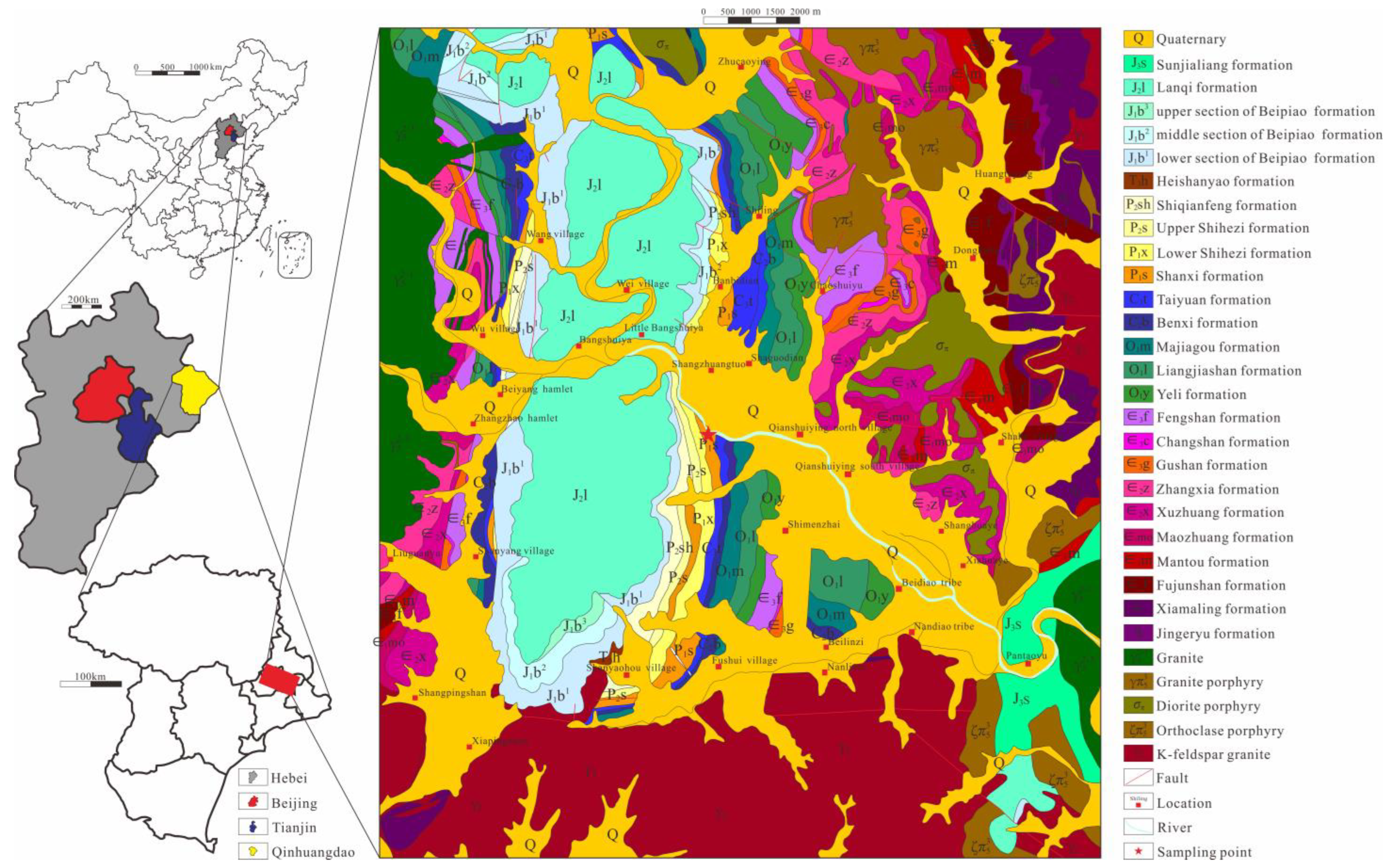
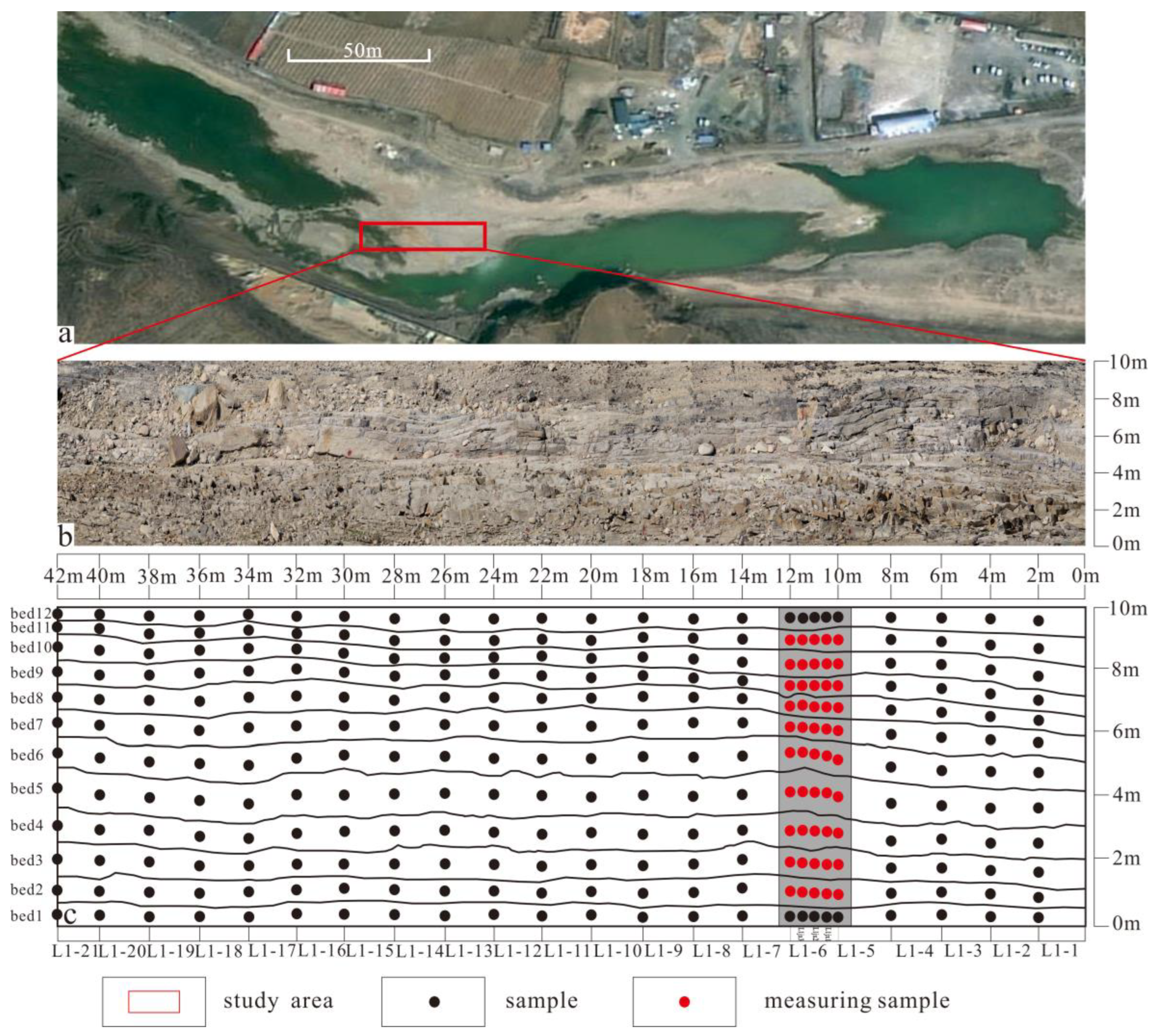
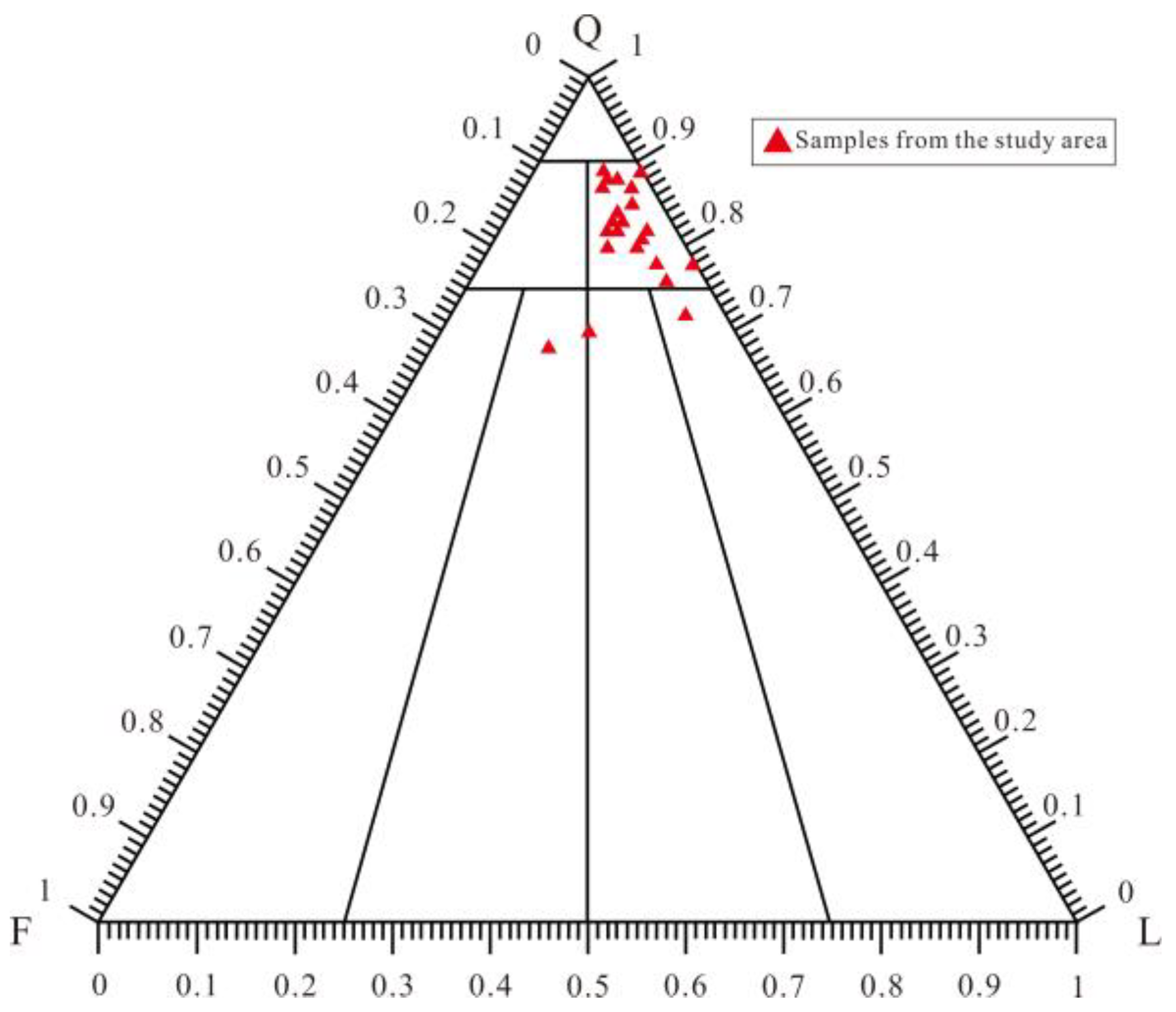
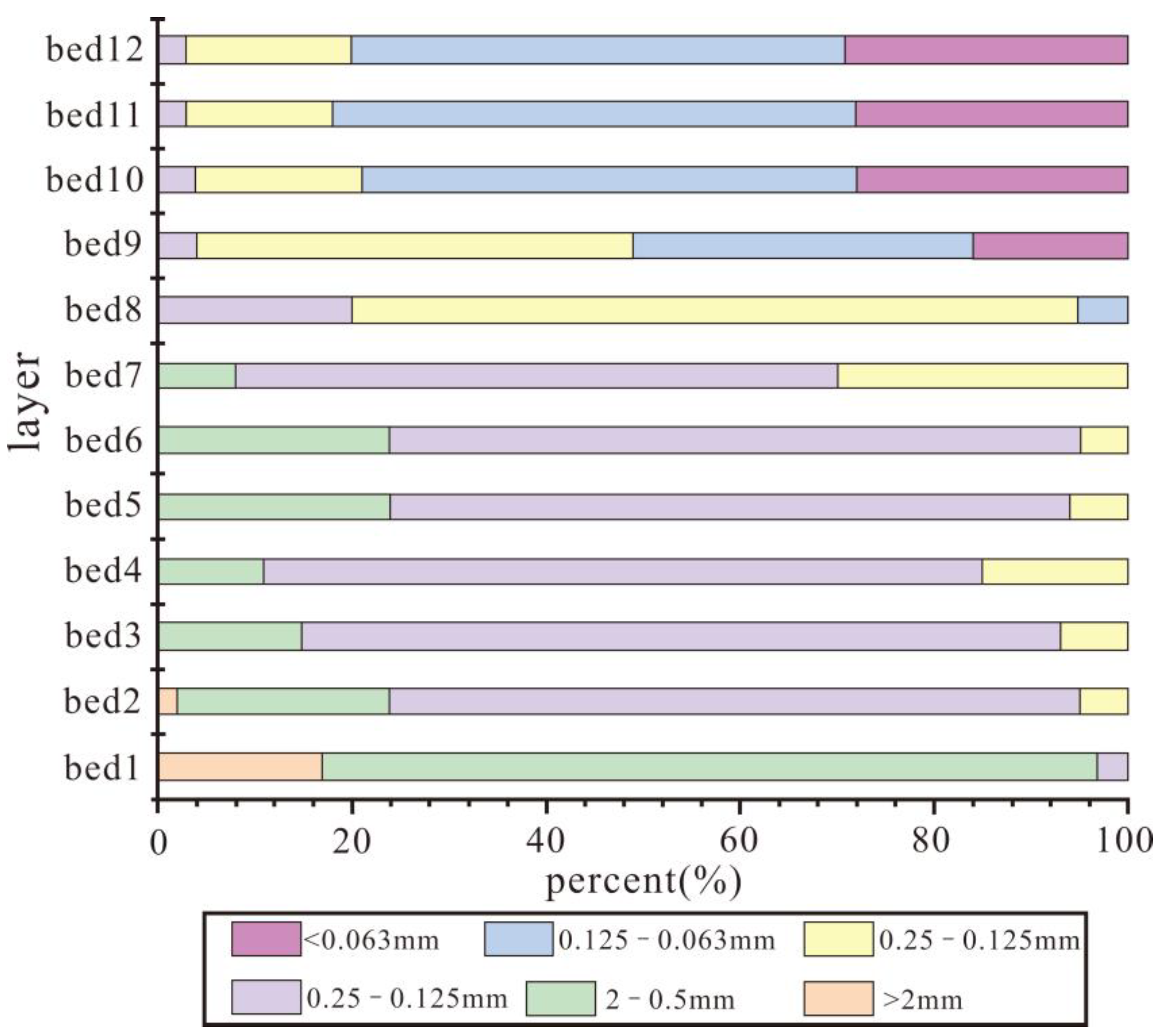
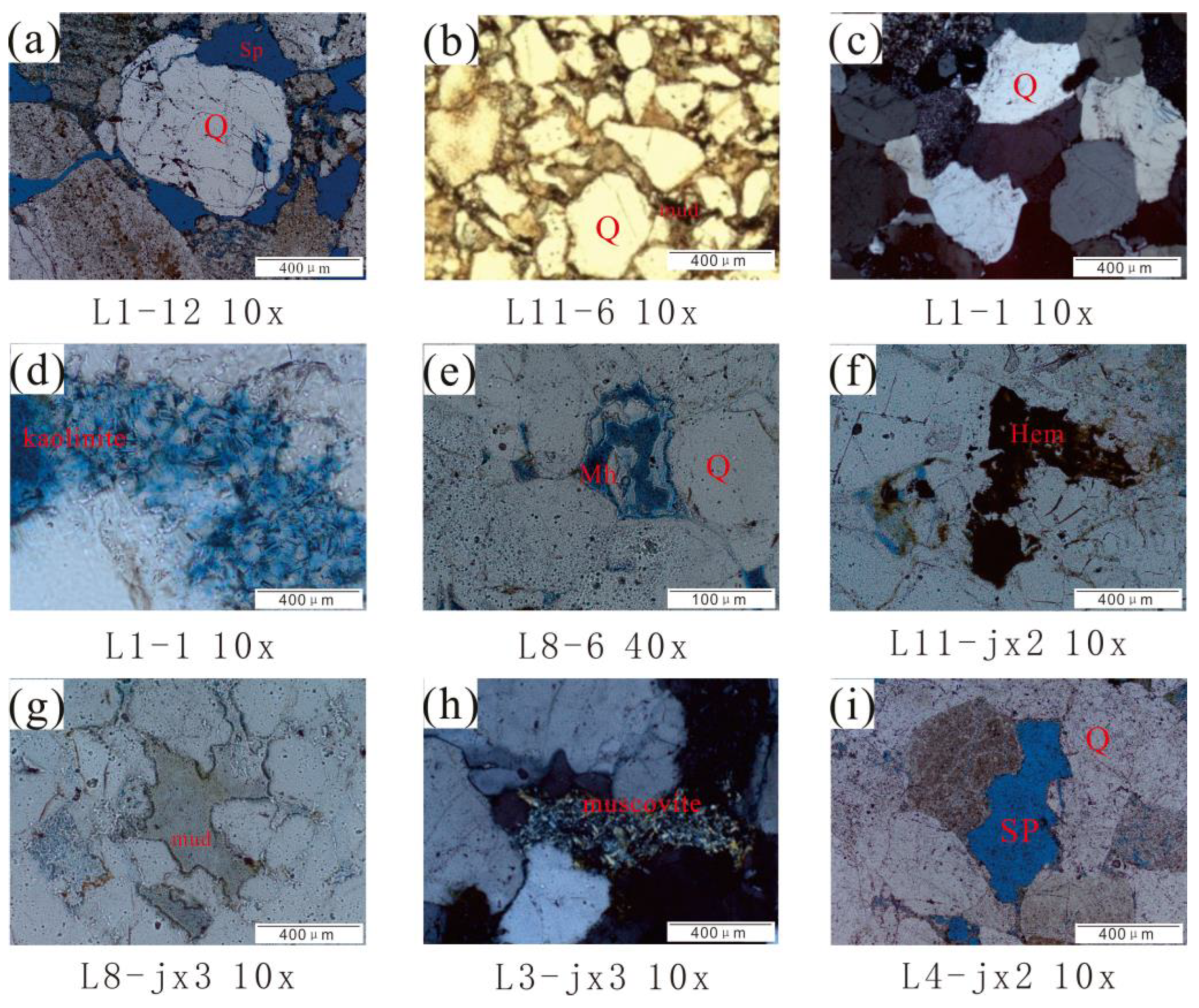


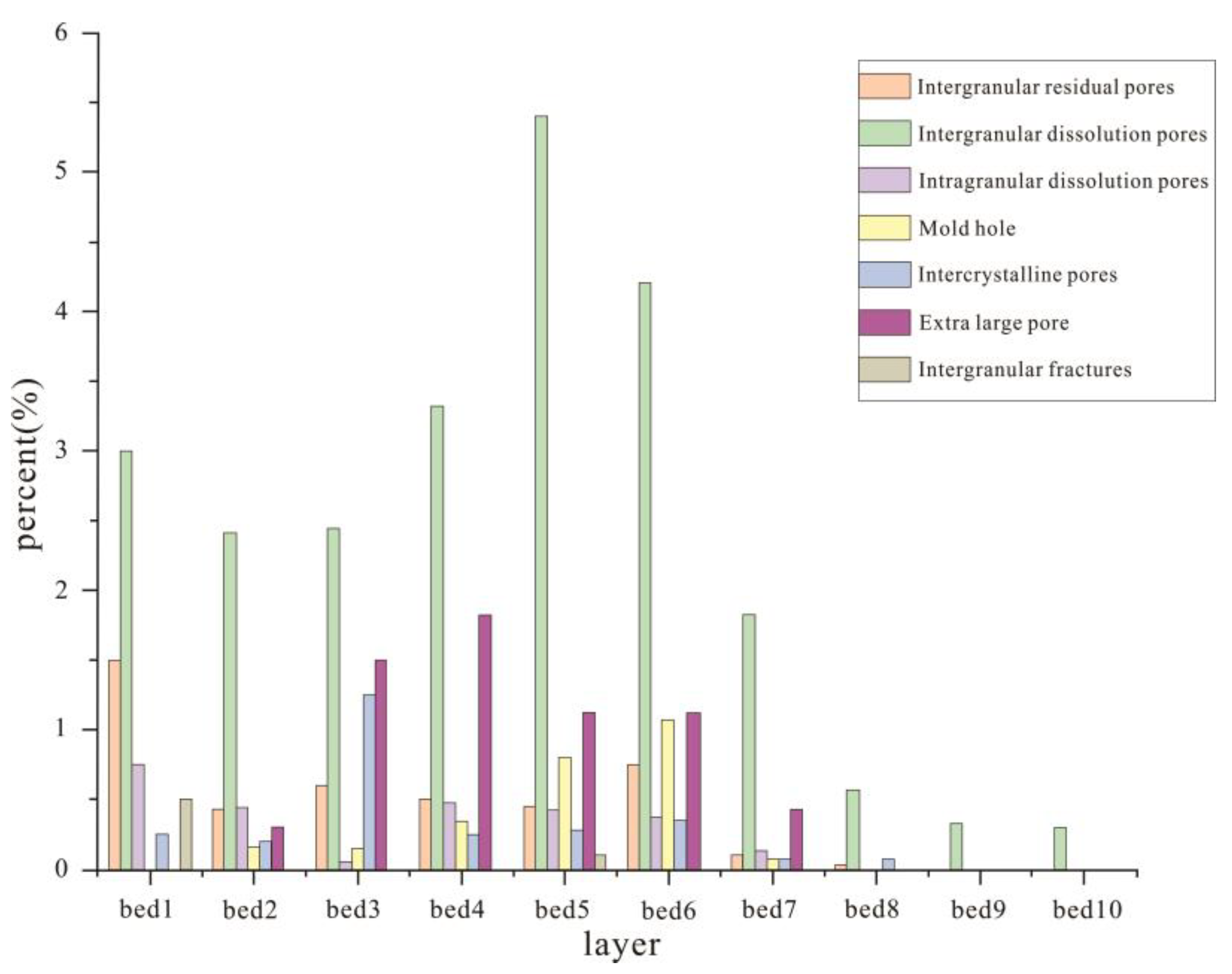
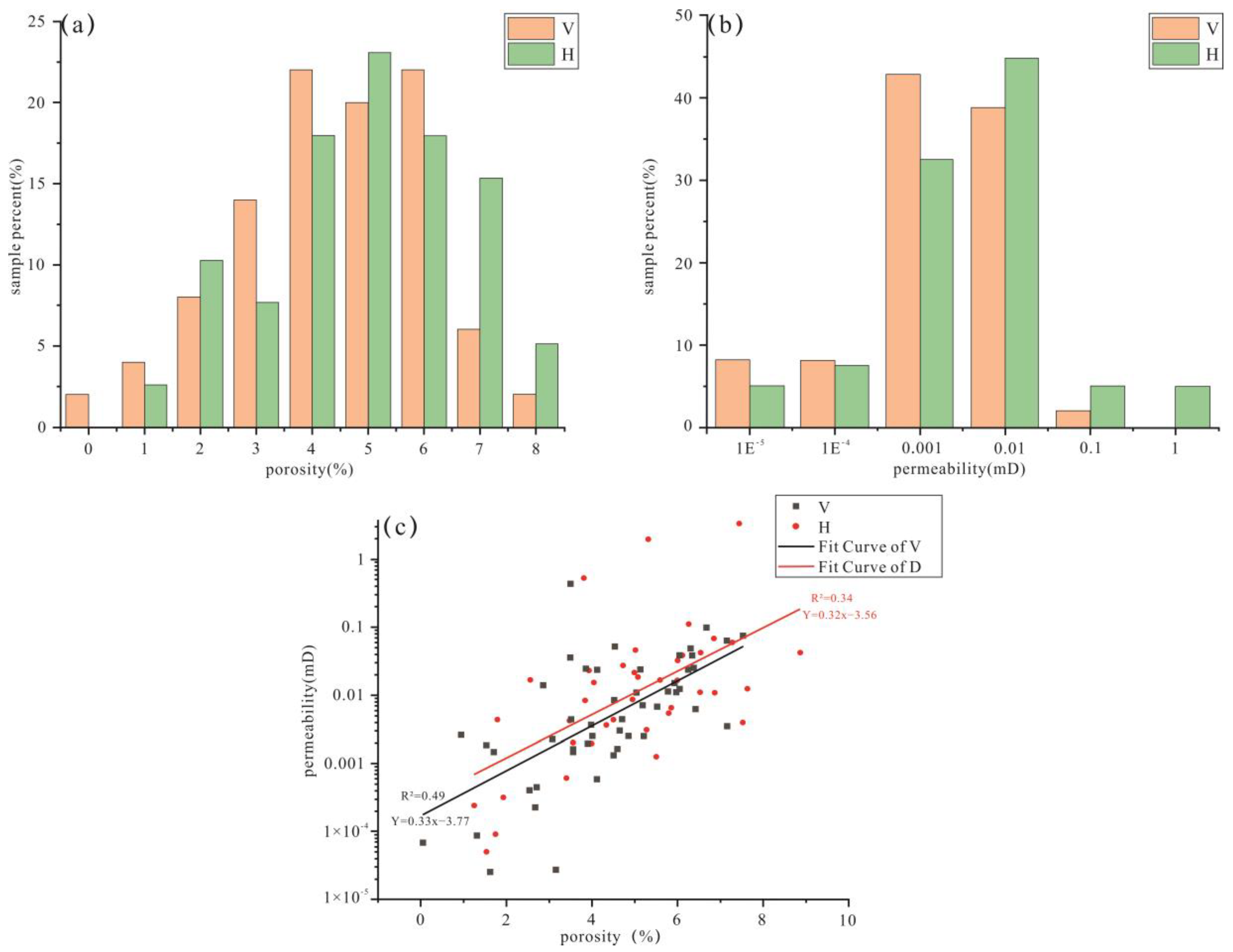
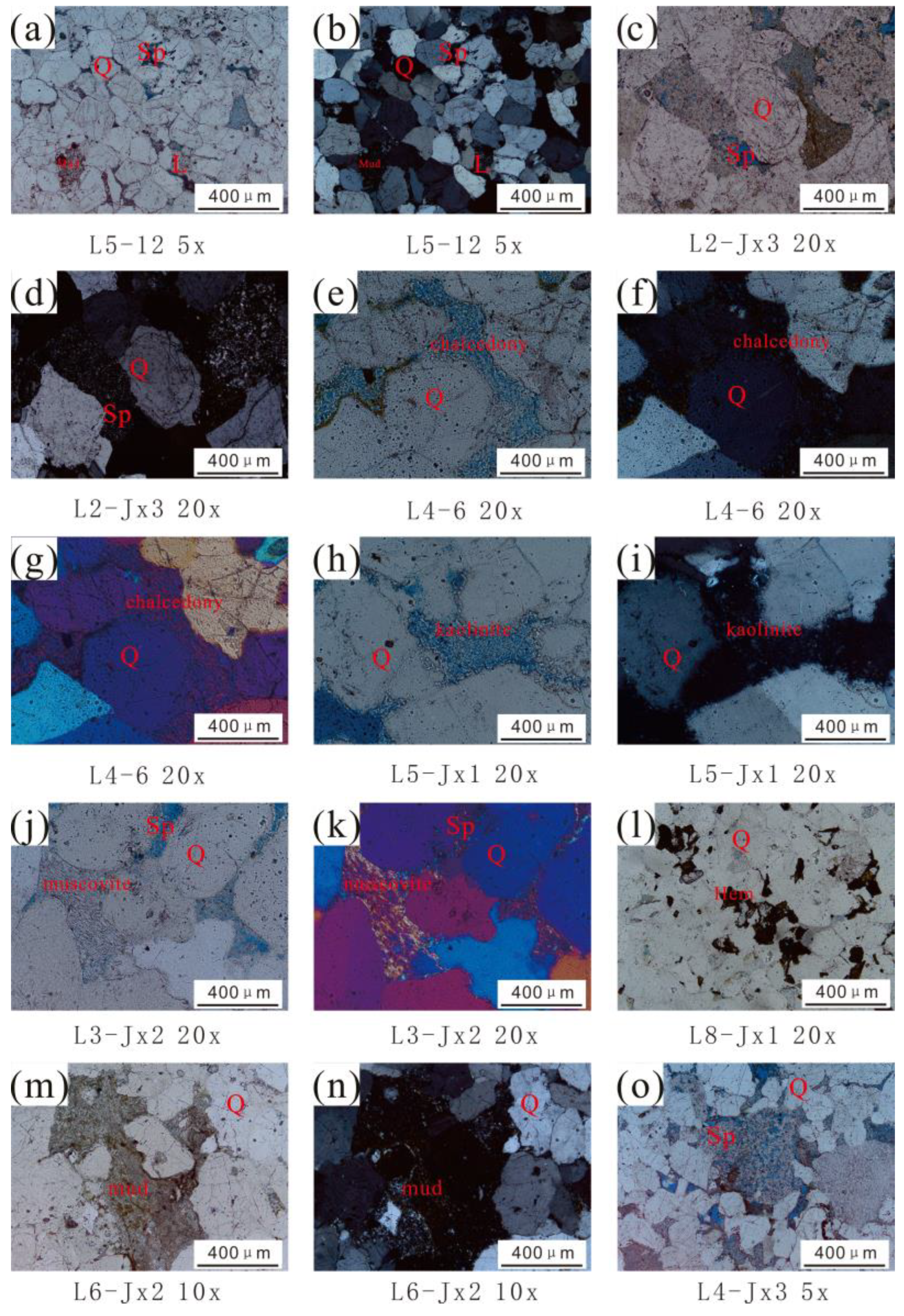
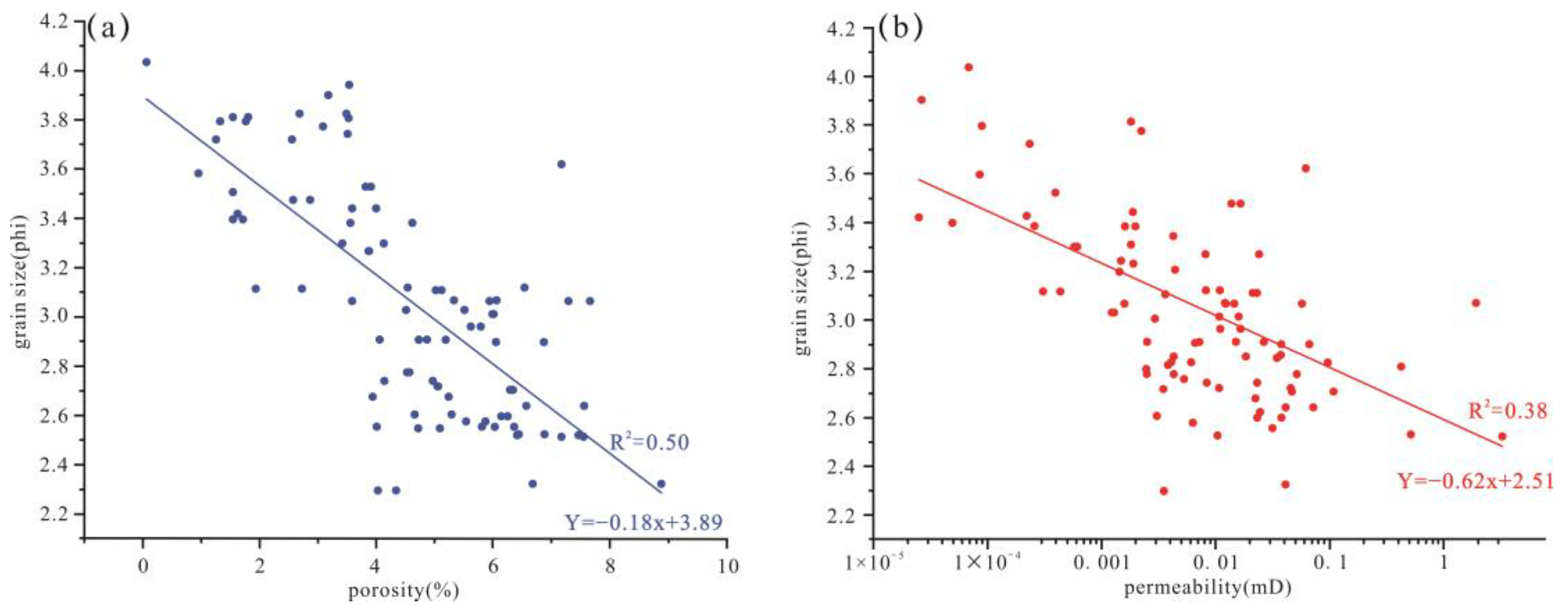

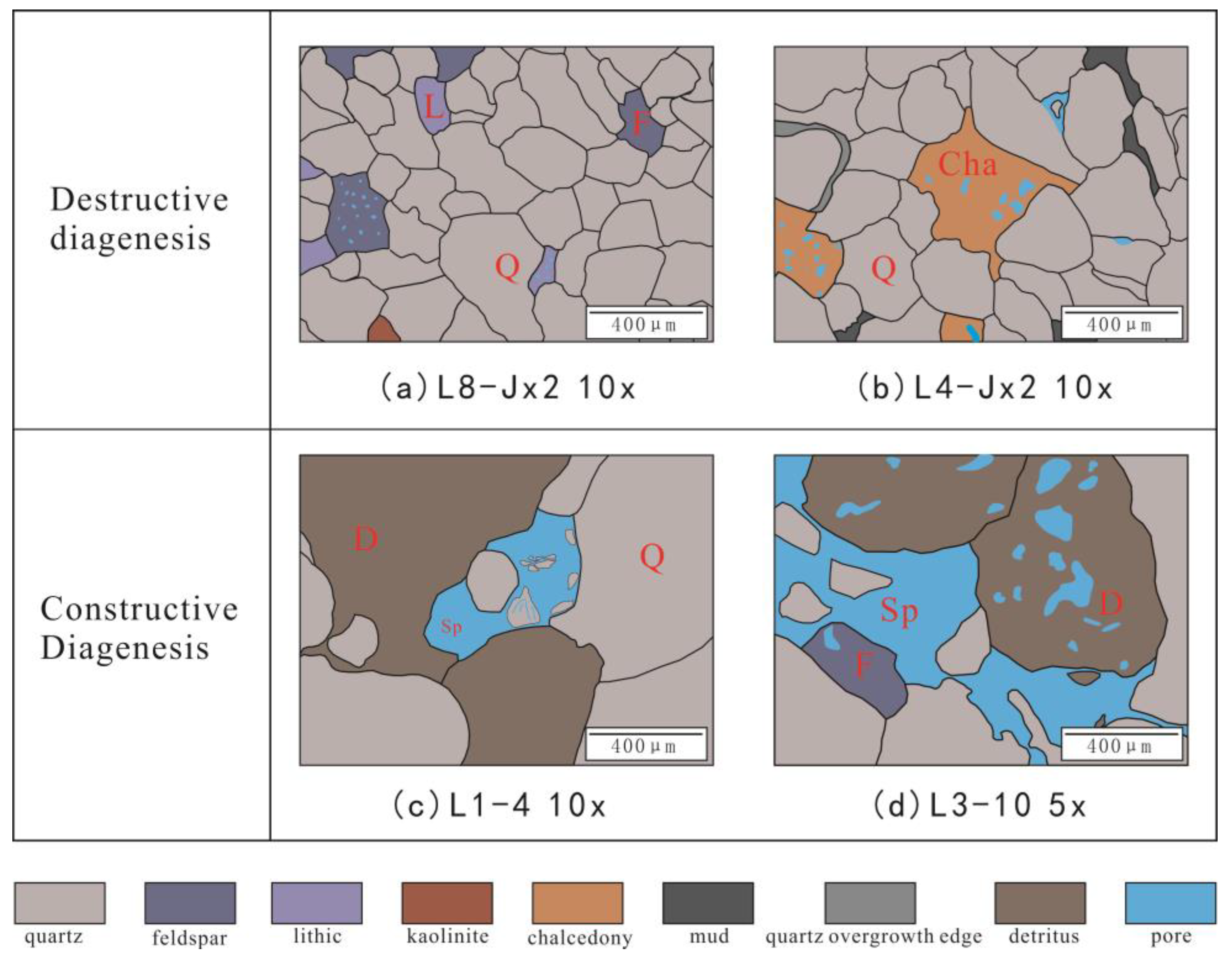

Disclaimer/Publisher’s Note: The statements, opinions and data contained in all publications are solely those of the individual author(s) and contributor(s) and not of MDPI and/or the editor(s). MDPI and/or the editor(s) disclaim responsibility for any injury to people or property resulting from any ideas, methods, instructions or products referred to in the content. |
© 2023 by the authors. Licensee MDPI, Basel, Switzerland. This article is an open access article distributed under the terms and conditions of the Creative Commons Attribution (CC BY) license (https://creativecommons.org/licenses/by/4.0/).
Share and Cite
Zhou, T.; Yuan, H.; Xu, F.; Wu, R. Tight Sandstone Reservoir Characteristics and Controlling Factors: Outcrops of the Shanxi Formation, Liujiang River Basin, North China. Energies 2023, 16, 4127. https://doi.org/10.3390/en16104127
Zhou T, Yuan H, Xu F, Wu R. Tight Sandstone Reservoir Characteristics and Controlling Factors: Outcrops of the Shanxi Formation, Liujiang River Basin, North China. Energies. 2023; 16(10):4127. https://doi.org/10.3390/en16104127
Chicago/Turabian StyleZhou, Tianqi, Hongqi Yuan, Fengming Xu, and Rigen Wu. 2023. "Tight Sandstone Reservoir Characteristics and Controlling Factors: Outcrops of the Shanxi Formation, Liujiang River Basin, North China" Energies 16, no. 10: 4127. https://doi.org/10.3390/en16104127
APA StyleZhou, T., Yuan, H., Xu, F., & Wu, R. (2023). Tight Sandstone Reservoir Characteristics and Controlling Factors: Outcrops of the Shanxi Formation, Liujiang River Basin, North China. Energies, 16(10), 4127. https://doi.org/10.3390/en16104127





